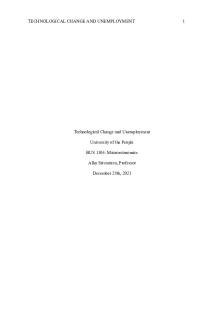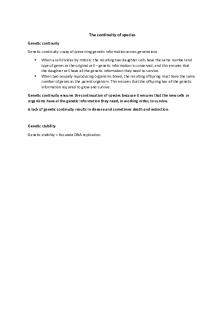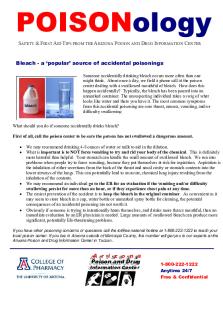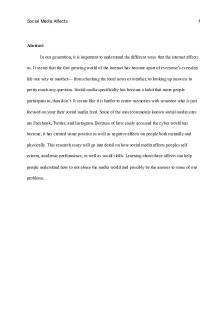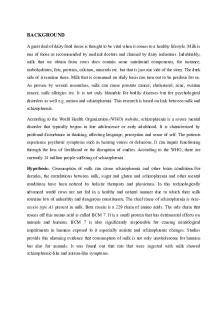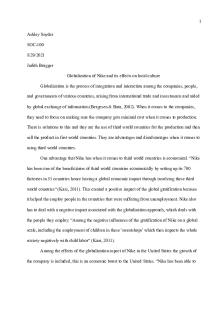Ozone Layer Depletion and Its Effects A Review PDF

| Title | Ozone Layer Depletion and Its Effects A Review |
|---|---|
| Author | Muhammad Usman |
| Course | Organic chemistry |
| Institution | Government College University Lahore |
| Pages | 9 |
| File Size | 562.2 KB |
| File Type | |
| Total Downloads | 40 |
| Total Views | 135 |
Summary
Ozone Layer Depletion and Its Effects A...
Description
See discussions, stats, and author profiles for this publication at: https://www.researchgate.net/publication/269838986
Ozone Layer Depletion and Its Effects: A Review ArticleinInternational Journal of Environmental Science and Development · January 2011 DOI: 10.7763/IJESD.2011.V2.93
CITATIONS
READS
68
115,554
2 authors, including: Sivasakthivel Thangavel Tokyo University of Agriculture and Technology 24 PUBLICATIONS426 CITATIONS SEE PROFILE
All content following this page was uploaded by Sivasakthivel Thangavel on 20 May 2018. The user has requested enhancement of the downloaded file.
International Journal of Environmental Science and Development, Vol.2, No.1, February 2011 ISSN: 2010-0264
Ozone Layer Depletion and Its Effects: A Review Sivasakthivel.T and K.K.Siva Kumar Reddy
Abstract - There are many situations where human activities have significant effects on the environment. Ozone layer damage is one of them. The objective of this paper is to review the origin, causes, mechanisms and bio effects of ozone layer depletion as well as the protective measures of this vanishing layer. The chlorofluorocarbon and the halons are potent ozone depletors. One of the main reasons for the widespread concern about depletion of the ozone layer is the anticipated increase in the amounts of ultraviolet radiation received at the surface of the earth and the effect of this on human health and on the environment. The prospects of ozone recovery remain uncertain. In the absence of other changes, stratospheric ozone abundances should rise in the future as the halogen loading falls in response to regulation. However, the future behaviour of ozone will also be affected by the changing atmospheric abundances of methane, nitrous oxide, water vapour, sulphate aerosol, and changing climate. Index Terms – Bio effects, chlorofluorocarbon, Ozone Layer Depletion, Protection.
I. INTRODUCTION The ozone layer is a layer in Earth's atmosphere which contains relatively high concentrations of ozone (O3). This layer absorbs 93-99% of the sun's high frequency ultraviolet light, which is potentially damaging to life on earth [1]. Over 91% of the ozone in Earth's atmosphere is present here.[1] It is mainly located in the lower portion of the stratosphere from approximately 10 km to 50 km above Earth, though the thickness varies seasonally and geographically[2]. The ozone layer was discovered in 1913 by the French physicists Charles Fabry and Henri Buisson. Its properties were explored in detail by the British meteorologist G. M. B. Dobson, who developed a simple spectrophotometer (the Dobson meter) that could be used to measure stratospheric ozone from the ground. Between 1928 and 1958 Dobson established a worldwide network of ozone monitoring stations which continues to operate today. The "Dobson unit", a convenient measure of the total amount of ozone in a column overhead, is named in his honor. A. Ozone Without ozone, life on Earth would not have evolved in the way it has. The first stage of single cell organism development requires an oxygen-free environment. This type of environment existed on earth over 3000 million years ago. As the primitive forms of plant life multiplied and evolved,
Manuscript Received, 27 November, 2010. *T.Sivasakthivel and K.K.Siva Kumar Reddy, M.Tech - Thermal Engineering,, Department of Mechanical Engineering,, N.I.T Silchar, Assam, India *Email: [email protected]
30
they began to release minute amounts of oxygen through the photosynthesis reaction (which converts carbon dioxide into oxygen) [3]. The buildup of oxygen in the atmosphere led to the formation of the ozone layer in the upper atmosphere or stratosphere. This layer filters out incoming radiation in the "cell-damaging" ultraviolet (UV) part of the spectrum. Thus with the development of the ozone layer came the formation of more advanced life forms. Ozone is a form of oxygen. The oxygen we breathe is in the form of oxygen molecules (O2) two atoms of oxygen bound together. Normal oxygen which we breathe is colourless and odourless. Ozone, on the other hand, consists of three atoms of oxygen bound together (O3). Most of the atmosphere's ozone occurs in the region called the stratosphere. Ozone is colourless and has a very harsh odour. Ozone is much less common than normal oxygen. Out of 10 million air molecules, about 2 million are normal oxygen, but only 3 are ozone. Most ozone is produced naturally in the upper atmosphere or stratosphere. While ozone can be found through the entire atmosphere, the greatest concentration occurs at altitudes between 19 and 30 km above the Earth's surface. This band of ozone-rich air is known as the "ozone layer". [4] Ozone also occurs in very small amounts in the lowest few kilometres of the atmosphere, a region known as the troposphere. It is produced at ground level through a reaction between sunlight and volatile organic compounds (VOCs) and nitrogen oxides (NOx), some of which are produced by human activities such as driving cars. Ground-level ozone is a component of urban smog and can be harmful to human health. Even though both types of ozone contain the same molecules, their presence in different parts of the atmosphere has very different consequences. Stratospheric ozone blocks harmful solar radiation - all life on Earth has adapted to this filtered solar radiation. Ground-level ozone, in contrast, is simply a pollutant. It will absorb some incoming solar radiation, but it cannot make up for ozone losses in the stratosphere. B. Ozone Hole In some of the popular news media, as well as in many books, the term "ozone hole" has and often still is used far too loosely. Frequently, the term is employed to describe any episode of ozone depletion, no matter how minor. Unfortunately, this sloppy language trivializes the problem and blurs the important scientific distinction between the massive ozone losses in Polar Regions and the much smaller, but nonetheless significant, ozone losses in other parts of the world. Technically, the term "ozone hole" should be applied to regions where stratospheric ozone depletion is so severe that levels fall below 200 Dobson Units (D.U.), the traditional measure of stratospheric ozone. Normal ozone
International Journal of Environmental Science and Development, Vol.2, No.1, February 2011 ISSN: 2010-0264
concentration is about 300 to 350 D.U [3]. Such ozone loss now occurs every springtime above Antarctica, and to a lesser extent the Arctic, where special meteorological conditions and very low air temperatures accelerate and enhance the destruction of ozone loss by man-made ozone depleting chemicals (ODCs). C. Ozone Layer The ozone layer is not really a layer at all, but has become known as such because most ozone particles are scattered between 19 and 30 kilometers (12 to 30 miles) up in the Earth's atmosphere, in a region called the stratosphere. The concentration of ozone in the ozone layer is usually under 10 parts ozone per million [5]. Without the ozone layer, a lot of ultraviolet (UV) radiation from the Sun would not be stopped reaching the Earth's surface, causing untold damage to most living species. In the 1970s, scientists discovered that chlorofluorocarbons (CFCs) could destroy ozone in the stratosphere. Ozone is created in the stratosphere when UV radiation from the Sun strikes molecules of oxygen (O2) and causes the two oxygen atoms to split apart. If a freed atom bumps into another O2, it joins up, forming ozone (O3). This process is known as photolysis. Ozone is also naturally broken down in the stratosphere by sunlight and by a chemical reaction with various compounds containing nitrogen, hydrogen and chlorine. These chemicals all occur naturally in the atmosphere in very small amounts. In an unpolluted atmosphere there is a balance between the amount of ozone being produced and the amount of ozone being destroyed. As a result, the total concentration of ozone in the stratosphere remains relatively constant. At different temperatures and pressures (i.e. varying altitudes within the stratosphere), there are different formation and destruction rates. Thus, the amount of ozone within the stratosphere varies according to altitude. Ozone concentrations are highest between 19 and 23 km [6]. Most of the ozone in the stratosphere is formed over the equator where the level of sunshine striking the Earth is greatest. It is transported by winds towards higher latitudes. Consequently, the amount of stratospheric ozone above a location on the Earth varies naturally with latitude, season, and from day-to-day. Under normal circumstances highest ozone values are found over the Canadian Arctic and Siberia, whilst the lowest values are found around the equator. The ozone layer over Canada is normally thicker in winter and early spring, varying naturally by about 25% between January and July. Weather conditions can also cause considerable daily variations.
D. Ozone depletion over India With so much worry about the rapid ozone depletion taking place in various parts of the earth, Indian scientists are closely monitoring the ozone layer over India for possible depletion trends. Opinions are many and varied. According to S K Srivastava, head of the National Ozone Centre in New Delhi, there is no trend to show total ozone depletion over India. V.Thaphyal and S M Kulshresta of the Indian Meteorological Department also point out that for the period 1956 to 1986 "ozone measurements exhibit year to year variability, but do not show any increasing or decreasing trend over India." However, former director of the National Ozone Centre, K Chatterji, now with Development Alternatives, warns that there is no case for complacency. He asserts that his calculations exhibit an ozone depletion trend in the upper, layers of the stratosphere over New Delhi and Pune from 1980 to 1983 in the month of October when the Antarctic ozone hole is at its maximum. Since India already receives high doses of ultraviolet (UV-B) radiation, and is at the threshold go to speak, effects of ozone layer depletion could he far more disastrous in India. A P Mitra, former director general of the Council of Scientific and Industrial Research, clarifies that while there is no trend in the total ozone value, there is some evidence of ozone depletion at higher altitudes at about 30 to 40 km - even over the tropics. He argues, however, that there is insufficient data and that the depletion may be due to solar cycles and other natural phenomena. However, the effects of CFCs and belong cannot be ruled out. Total column ozone data has been recorded over India for a long time. A network of stations using Dobson spectrophotometers to mea- sure total ozone, some six times a day, covers Srinagar, New Delhi, Varanasi, Ahmedabad, Pone and Kodaikanal. Ozone profiles are also regularly recorded using balloons. Ozone levels are the lowest during November and December and the highest in summer. Across the country, variations do exist. In Kodaikanal, the total ozone is 240 to 280 Dobson units (DU), in New Delhi 270 to 320 DU and in Srinagar 290 to 360 DU. One Dobson unit is the equivalent of 0.01 mm of compressed gas at a pressure of 760 rare mercury and 0°C.B N Srivastava of the National Physical Laboratory, who been working on incident UVradiation levels, says that during summer, at noon, the UV-B radiation with a wavelength of 290 nanometer (nm) is equivalent to levels attained in the Antarctica during the ozone hole period. He warns that even a slight depletion of the ozone layer over India may lead to large percentage changes in UV-B radiation over the country. According to eminent skin specialists in New Delhi, the incidence of skin cancer in India is low, but they admit that the surveys conducted to identify any trends are inadequate. Controlled studies to observe the effects of changing UV- B radiation concentrations on crops are on, they said. However no field surveys have been done in the country as yet. E. Measuring Ozone Depletion The most common stratospheric ozone measurement unit is the Dobson Unit (DU). The Dobson Unit is named after the atmospheric ozone pioneer G.M.B. Dobson who carried out the earliest studies on ozone in the atmosphere from the 1920s to the 1970s. A Dobson Unit measures the total amount of ozone in an overhead column of the atmosphere. Dobson Units are measured by how thick the layer of ozone would be if it were compressed into one layer at 0 degrees Celsius and with a pressure of one atmosphere above it. Every 0.01
Fig.1 ozone layer depletion over Antarctica
31
International Journal of Environmental Science and Development, Vol.2, No.1, February 2011 ISSN: 2010-0264
millimeter thickness of the layer is equal to one Dobson Unit [8]. The average amount of ozone in the stratosphere across the globe is about 300 DU (or a thickness of only 3mm at 0°C and 1 atmospheric pressure!). Highest levels of ozone are usually found in the mid to high latitudes, in Canada and Siberia (360DU). When stratospheric ozone falls below 200 DU this is considered low enough to represent the beginnings of an ozone hole. Ozone holes of course commonly form during springtime above Antarctica, and to a lesser extent the Arctic. F. The Ozone Hole 2009 I. Situation at 2009 November the 2009 ozone hole is now waning, with much of the continent experiencing a stratospheric spring warming. The residual vortex is over the Weddell Sea and Antarctic Peninsula and here minimum values are around 160 DU and depletion exceeds 50%. Ozone values outside the polar vortex have dropped to near 400 DU, and inside the vortex ozone values are increasing as the atmosphere warms [7]. The temperature of the ozone layer over Antarctica is now rising, though a small area is still cold enough for polar stratospheric clouds (PSCs) to exist. During the early winter, the polar vortex was often rather more elliptical than it was in 2008, and this lead to some early depletion in circumpolar regions as stratospheric clouds became exposed to sunlight. It reverted to a more circular circulation as winter progressed and this led to another relatively slow start to the growth of the ozone hole (as measured by NASA/SBUV2), with the "hole" not beginning until mid August. The vortex became more elliptical again in late August, with South Georgia being affected by the fringes of the ozone hole between September 2 and 6. The hole grew to reach an area of around 24 million square kilometers by mid September, but had declined to 12 million square kilometres by mid November. It is now a little larger than the average for the past decade. The tip of South America and South Georgia were affected by the fringes of the ozone hole from September 24 to September 30 and again from October 3 to October 7.
Fig.3 ozone hole area variation over different continent
G. Ozone Layer Recovery The ozone depletion caused by human-produced chlorine and bromine compounds is expected to gradually disappear by about the middle of the 21st century as these compounds are slowly removed from the stratosphere by natural processes. This environmental achievement is due to the landmark international agreement to control the production and use of ozone-depleting substances. Full compliance would be required to achieve this expected recovery. Without the Montreal Protocol and its Amendments, continuing use of chlorofluorocarbons (CFCs) and other ozone-depleting substances would have increased the stratospheric abundances of chlorine and bromine tenfold by the mid-2050s compared with the 1980 amounts [9]. Such high chlorine and bromine abundances would have caused very large ozone losses, which would have been far larger than the depletion observed at present. In contrast, under the current international agreements that are now reducing the human-caused emissions of ozone-depleting gases, the net troposphere concentrations of chlorineand bromine-containing compounds started to decrease in 1995. Because 3 to 6 years are required for the mixing from the troposphere to the stratosphere, the stratospheric abundances of chlorine are starting to reach a constant level and will slowly decline thereafter. With full compliance, the international agreements will eventually eliminate most of the emissions of the major ozone-depleting gases. All other things being constant, the ozone layer would be expected to return to a normal state during the middle of the next century. This slow recovery, as compared with the relatively rapid onset of the ozone depletion due to CFC and bromine-containing halons emissions, is related primarily to the time required for natural processes to eliminate the CFCs and halons from the atmosphere. Most of the CFCs and halons have atmospheric residence times of about 50 to several hundred years [7]. II. CAUSES OF OZONE DEPLETION Ozone depletion occurs when the natural balance between the production and destruction of stratospheric ozone is tipped in favour of destruction. Although natural phenomena can cause temporary ozone loss, chlorine and bromine released from man-made compounds such as CFCs are now accepted as the main cause of this depletion [10]. It was first suggested by Drs. M. Molina and S. Rowland in 1974 that a man-made group of compounds known as the chlorofluorocarbons (CFCs) were likely to be the main source of ozone depletion. However, this idea was not taken
Fig.2 ozone hole area variation
32
International Journal of Environmental Science and Development, Vol.2, No.1, February 2011 ISSN: 2010-0264
seriously until the discovery of the ozone hole over Antarctica in 1985 by the Survey. Chlorofluorocarbons are not "washed" back to Earth by rain or destroyed in reactions with other chemicals. They simply do not break down in the lower atmosphere and they can remain in the atmosphere from 20 to 120 years or more. As a consequence of their relative stability, CFCs are instead transported into the stratosphere where they are eventually broken down by ultraviolet (UV) rays from the Sun, releasing free chlorine. The chlorine becomes actively involved in the process of destruction of ozone. The net result is that two molecules of ozone are replaced by three of molecular oxygen, leaving the chlorine free to repeat the process: Cl + O3 = ClO + O2 ClO + O = Cl + O2 Ozone is converted to oxygen, leaving the chlorine atom free to repeat the process up to 100,000 times, resulting in a reduced level of ozone. Bromine compounds, or halons, can also destroy stratospheric ozone. Compounds containing chlorine and bromine from man-made compounds are known as industrial halocarbons. Emissions of CFCs have accounted for roughly 80% of total stratospheric ozone depletion. Thankfully, the developed world has phased out the use of CFCs in response to international agreements to protect the ozone layer. However, because CFCs remain in the atmosphere so long, the ozone layer will not fully repair itself until at least the middle of the 21st century. Naturally occurring chlorine has the same effect on the ozone layer, but has a shorter life span in the atmosphere. A. Chlorofluorocarbons Chlorofluorocarbons or CFCs (also known as Freon) are non-toxic, non-flammable and non-carcinogenic. They contain fluorine atoms, carbon atoms and chlorine atoms. The 5 main CFCs include CFC-11 (trichlorofluoromethane CFCl3), CFC-12 (dichloro-difluoromethane - CF2Cl2), CFC-113 (trichloro-trifluoroethane - C2F3Cl3), CFC-114 (dichloro-tetrfluoroethane - C2F4Cl2), and CFC-115 (chloropentafluoroethane - C2F5Cl).CFCs are widely used as coolants in refrigeration and air conditioners, as solvents in cleaners, particularly for electronic circuit boards, as a blowing agents in the production of foam (for example fire extinguishers), and as propellants in aerosols. Indeed, much of the modern lifestyle of the second half of the 20th century had been made possible by the use of CFCs.Man-made CFCs however, are the main cause of stratospheric ozone depletion [11]. CFCs have a lifetime in the atmosphere of about 20 to 100 years, and consequently one free chlori...
Similar Free PDFs

Oc spray and its effects
- 3 Pages

2 Depreciation and Depletion
- 28 Pages

Data Encapsulation and OSI Layer
- 18 Pages
Popular Institutions
- Tinajero National High School - Annex
- Politeknik Caltex Riau
- Yokohama City University
- SGT University
- University of Al-Qadisiyah
- Divine Word College of Vigan
- Techniek College Rotterdam
- Universidade de Santiago
- Universiti Teknologi MARA Cawangan Johor Kampus Pasir Gudang
- Poltekkes Kemenkes Yogyakarta
- Baguio City National High School
- Colegio san marcos
- preparatoria uno
- Centro de Bachillerato Tecnológico Industrial y de Servicios No. 107
- Dalian Maritime University
- Quang Trung Secondary School
- Colegio Tecnológico en Informática
- Corporación Regional de Educación Superior
- Grupo CEDVA
- Dar Al Uloom University
- Centro de Estudios Preuniversitarios de la Universidad Nacional de Ingeniería
- 上智大学
- Aakash International School, Nuna Majara
- San Felipe Neri Catholic School
- Kang Chiao International School - New Taipei City
- Misamis Occidental National High School
- Institución Educativa Escuela Normal Juan Ladrilleros
- Kolehiyo ng Pantukan
- Batanes State College
- Instituto Continental
- Sekolah Menengah Kejuruan Kesehatan Kaltara (Tarakan)
- Colegio de La Inmaculada Concepcion - Cebu


